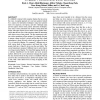Free Online Productivity Tools
i2Speak
i2Symbol
i2OCR
iTex2Img
iWeb2Print
iWeb2Shot
i2Type
iPdf2Split
iPdf2Merge
i2Bopomofo
i2Arabic
i2Style
i2Image
i2PDF
iLatex2Rtf
Sci2ools
CHI
2002
ACM
2002
ACM
Interacting at a distance: measuring the performance of laser pointers and other devices
It is difficult to interact with computer displays that are across the room. A popular approach is to use laser pointers tracked by a camera, but interaction techniques using laser pointers tend to be imprecise, error-prone, and slow. Although many previous papers discuss laser pointer interaction techniques, none seem to have performed user studies to help inform the design. This paper reports on two studies of laser pointer interactions that answer some of the questions related to interacting with objects using a laser pointer. The first experiment evaluates various parameters of laser pointers. For example, the time to acquire a target is about 1 second, and the jitter due to hand unsteadiness is about ?8 pixels, which can be reduced to about ?2 to ?4 pixels by filtering. We compared 7 different ways to hold various kinds of laser pointers, and found that a laser pointer built into a PalmOS device was the most stable. The second experiment compared 4 different ways to select object...
CHI 2002 | Human Computer Interaction | Laser Pointer | Laser Pointer Interaction | Laser Pointer Interactions |
| Added | 01 Dec 2009 |
| Updated | 01 Dec 2009 |
| Type | Conference |
| Year | 2002 |
| Where | CHI |
| Authors | Brad A. Myers, Rishi Bhatnagar, Jeffrey Nichols, Choon Hong Peck, Dave Kong, Robert C. Miller, A. Chris Long |
Comments (0)

